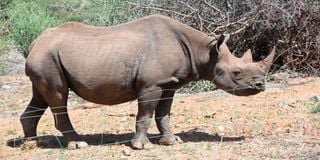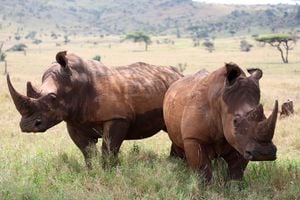Calls for concerted efforts to conserve endangered black rhinos

A black rhino named Loijipu at Sera Conservancy Sanctuary in Samburu County on May 11, 2022.
What you need to know:
- Kenya is currently home to about 1,004 eastern black rhinos and 973 white rhinos, hosting the third largest population of rhinos in the continent after South Africa and Namibia.
Community conservancies have been urged to support the government in its efforts to double the population of the critically endangered black rhinos by 2037.
Kenya is currently home to about 1,004 eastern black rhinos and 973 white rhinos, hosting the third largest population of rhinos in the continent after South Africa and Namibia.
According to the Recovery and Action Plan for Black Rhino in Kenya (2022-2026), the country targets to increase the black rhino population to 1,200 by 2026 and have more than 2,000 by 2037.
Speaking during this year’s World Rhino Day at Sera in Samburu County, Tourism and Wildlife Cabinet Secretary Rebecca Miano called for concerted efforts to conserve the endangered black rhinos.
Serais the first community conservancy in East Africa to establish a community-led rhino sanctuary which now hosts 22 black rhinos and five white rhinos.
The conservancy, which is supported by Northern Rangeland Trust (NRT), reintroduced 10 black rhinos into the area in 2015, 30 years after the animals were wiped out of Northern Kenya through poaching.
CS Miano said the government is keen on involving communities in conservation to reverse the fate of critically endangered animals.
“The continued coexistence of humans and wildlife in private and community owned spaces gives me hope that Kenya will continue leading from the front in wildlife conservation, including offering safe sanctuaries for rare animal species such as the rhino,” Ms Miano said.
She lauded Sera community conservancy as a key breeding ground for black rhinos, saying it serves as an example that communities can offer safe havens for endangered species.
Ms Miano said the ongoing efforts by researchers to save the southern white rhino from extinction would place Kenya at the forefront of wildlife guardianship globally.Sera Community Conservancy Board Chairman Joseph Lentaka said the success of the black rhino reintroduction advised the recent translocation of white rhinos into their sanctuary.
“Kenya Wildlife Service scientists have applauded the Sera rhino sanctuary for recording a higher breeding rate than the national average. The community has been very supportive and we have thus not recorded any poaching incident for the last nine years,” Mr Lentaka said.
He said the community intends to grow the rhino population in the 10,700-hectare sanctuary to a maximum of 60 in the next 10 years.
“We have been able to achieve the safety of the rhinos through well trained rangers and fence monitors. We also use advanced technology to track and monitor the animals to avert any threat. Once we reach the recommended population of 60 rhinos, we will be able to translocate to other areas,” he said.
Mr Lentaka said the community is currently reaping from the gains of rhino conservation through employment of 114 locals and income from rhino tracking by tourists.
Kenya has been lauded for recovering the population of black rhinos from about 400 in the 1980s, when their numbers declined due to poaching and habitat loss, to more than 1,000.
According to the International Rhino Foundation, there are 6,421 black rhinos and 17,464 white rhinos left in the wild in Africa.
World Rhino Day is observed annually on September 22.





